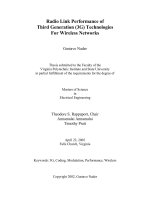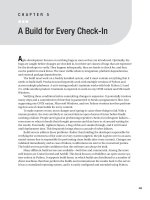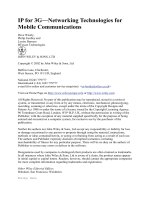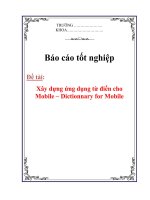Mobile technologies for every library
Bạn đang xem bản rút gọn của tài liệu. Xem và tải ngay bản đầy đủ của tài liệu tại đây (1.29 MB, 127 trang )
MobileTechnologiesforEveryLibrary
MedicalLibraryAssociationBooks
TheMedicalLibraryAssociation(MLA)featuresbooksthatshowcasetheexpertise
ofhealthscienceslibrariansforotherlibrariansandprofessionals.MLABooksare
excellentresourcesforlibrariansinhospitals,medicalresearchpractice,andother
settings.Thesevolumeswillprovidehealthcareprofessionalsandpatientswith
accurateinformationthatcanimproveoutcomesandsavelives.Eachbookinthe
serieshasbeenoverseeneditoriallysinceconceptionbytheMedicalLibrary
AssociationBooksPanel,composedofMLAmemberswithexpertisespanningthe
breadthofhealthscienceslibrarianship.
MedicalLibraryAssociationBooksPanel
BarbaraGushrowski,chair
LaurenM.Young,AHIP,chairdesignate
MichelC.Atlas
DorothyC.May
KarenMcElfresh
MeganCurranRosenbloom
TracyShields
KristenL.Young,AHIP
HeidiHeilemann,AHIP,boardliaison
AbouttheMedicalLibraryAssociation
Foundedin1898,MLAisa501(c)(3)nonprofit,educationalorganizationof4,000
individualandinstitutionalmembersinthehealthsciencesinformationfieldthat
provideslifelongeducationalopportunities,supportsaknowledgebaseofhealth
informationresearch,andworkswithaglobalnetworkofpartnerstopromotethe
importanceofqualityinformationforimprovedhealthtothehealthcarecommunity
andthepublic.
BooksinSeries
TheMedicalLibraryAssociationGuidetoProvidingConsumerandPatientHealth
Information,editedbyMicheleSpatz
HealthSciencesLibrarianship,editedbyM.SandraWood
Curriculum-BasedLibraryInstruction:FromCultivatingFacultyRelationshipsto
Assessment,editedbyAmyBlevinsandMeganInman
MobileTechnologiesforEveryLibrary,byAnnWhitneyGleason
MobileTechnologiesforEveryLibrary
AnnWhitneyGleason
ROWMAN&LITTLEFIELD
Lanham•Boulder•NewYork•London
PublishedbyRowman&Littlefield
AwhollyownedsubsidiaryofTheRowman&LittlefieldPublishingGroup,Inc.
4501ForbesBoulevard,Suite200,Lanham,Maryland20706
www.rowman.com
UnitA,WhitacreMews,26-34StannaryStreet,LondonSE114AB
Copyright©2015bytheMedicalLibraryAssociation
PublishedincooperationwiththeMedicalLibraryAssociation
Allrightsreserved.Nopartofthisbookmaybereproducedinanyformorbyanyelectronicormechanicalmeans,
includinginformationstorageandretrievalsystems,withoutwrittenpermissionfromthepublisher,exceptbya
reviewerwhomayquotepassagesinareview.
BritishLibraryCataloguinginPublicationInformationAvailable
LibraryofCongressCataloging-in-PublicationData
Gleason,AnnWhitney,1960–
Mobiletechnologiesforeverylibrary/AnnWhitneyGleason.
pagescm.—(MedicalLibraryAssociationbooks)
Includesbibliographicalreferencesandindex.
ISBN978-1-4422-4891-5(hardback:alk.paper)—ISBN978-1-4422-4892-2(pbk.:alk.paper)1.Mobile
communicationsystems—Libraryapplications.I.Title.
Z680.5.G582015
025.0422—dc23
2014046357
TMThepaperusedinthispublicationmeetstheminimumrequirementsofAmericanNationalStandardfor
InformationSciencesPermanenceofPaperforPrintedLibraryMaterials,ANSI/NISOZ39.48-1992.
PrintedintheUnitedStatesofAmerica
Preface
Mobiletechnologyiseverywhere.Youseeitonbuses,atthebeach,while
walkingoncitysidewalks,andubiquitouslyinmostpublicspaces.TheHorizonReport
for2013ratedtabletcomputersasoneofthetwotopemergingtechnologiesin
highereducation.GartnerResearchlistedmobileappsasoneofthetopstrategic
technologytrendsfor2014.Inthesummerof2014,itwasreportedthattherewere
1.2millionactiveappsintheAppleStore.Atthesametime,Androidreportedover
1.3millionavailableapps.Hobbies,health,beauty,science,nature,travel;thereisan
appforeverythingnow.Businessesuseappstoreachouttonewmarketsand
customers.ThousandsofappsareaddedmonthlytotheAppleStoreandGoogle
AppsMarketplace.Thetimetowatchandwaitformobiletechnologytomatureis
over;nowisthetimetoadoptmobiletechnologytoenhanceyourlibraryprograms
andservices.
Ifyouarewonderingwhatmobiletechnologyadoptionmeansforyouorhowto
getstarted,thisbookwillansweryourquestionsindetail.Wonderingaboutthe
opportunitiesandpitfallsofmobiletechnologyuseinlibraries?Thisbookwillanswer
yourquestions.Thinkingofstartingamobileprograminyourlibrary?Wanttoimprove
onexistingservicesoraddnewones?Thisbookwilladdressquestionsabout
platforms,options,security,bestpractices,andmore.Youwillfindpreviewsofmany
usefulappsforlibraries.Weblinksandresourcesforfurtherresearcharealso
included.
MobileTechnologiesforEveryLibraryisorganizedbychaptersonspecific
topicsrelatedtomobiletechnology,includingthehistoryofmobiletechnology,existing
typesofmobiletechnologies,popularmobiledevices,andsupportingtechnologies.
Waystoprovidemobiletechnologyforyourusers,asurveyofcurrentlyavailable
appsofusetolibraries,waystousemobiletechnologyforlibrarywork,best
practices,andfuturedirectionsarediscussedindetail.Eachchapterisorganizedby
subtopicswithtipsandexamplesfromreallibraryprogramstohelpyougetstarted
withusingmobiletechnologyinyourlibrary.
Chapter1givesbackgroundinformationaboutmobiletechnologyandprovidesa
concisehistoryofmobiledevices.Chapter2givesdetailedinformationonthepopular
mobiledevicesinusetoday,aswellasinformationaboutsupportingtechnologies
suchaswirelessnetworking.Chapter3presentsinformationonmakingthelibrary
websitemoreaccessibletomobileusers.Chapter4discussesappsforlibrariesand
coversappdevelopmentforthosewhoareinterestedincreatingalibraryapp.
Chapter5presentsthewaysthatpeopleusemobiletechnologytoaccess
information,thetypesofinformationsearchedfor,andwhatthatmeansforlibraries.
Chapter6listsbycategoryselectedappsthatareparticularlyusefultolibraries.
Chapter7givesguidelinesandbestpracticesforavarietyofmobiletechnology
programsinlibraries.Chapter8presentsideasforusingmobiletechnologyinlibrary
education.Chapter9providesideasfordoinglibraryoutreachandcommunication
withmobiletechnology,andchapter10discussesfuturetrendsanddirections.
Readonandpreparetowelcomemobiletechnologyintoyourlibrary!
Chapter1
BackgroundandHistoryof
MobileTechnology
NetworkingtechnologycompanyCiscoSystems,Inc.statedinaSeptember
2013articlethatmobileInternetisthetopdisruptivetechnologylikelytochangeour
livesinthenextdecade.[1]Adisruptivetechnologyisdefinedasonethatcreatesa
newmarketforconsumersandgoesontodisplaceformertechnologies.TheCisco
articleproposedthatwiththerapidgrowthofthemobileInternet,themajorityof
peoplenotpreviouslyconnectedtotheInternetwillconnectthroughmobiledevices.
AlsoinSeptember2013,PewResearchCenterreportedinits“CellInternetUse
2013”reportthatalmosttwo-thirdsofcellphoneownerssurveyedgoonlineusing
mobilephones.[2]Thereareover300millioncellphoneusersintheUnitedStates
alone.Clearly,mobiletechnologyisagame-changinginnovation.Theimplicationsof
thisriseinmobileaccesstotheInternetarehugeforbusinesseswantingtoreach
futuremobilemarkets.Librariesalsoneedtotakethemobilerevolutionseriouslyand
planforservicestomobileusersiftheywishtoremainrelevantinanincreasingly
mobileworld.
Mostlibrarieshaveexistingwebsitesgivingpatronsaccesstolibraryinformation,
resources,andservicesonline.Somelibrarieshavecreatedmobile-friendlywebsites
butfewprovidefullmobileaccess.TheAmericanLibraryAssociation’s“Stateof
America’sLibrariesReport2013”notesthatlibrariescontinuetoofferimportant
servicesduringthecurrentU.S.economicdownturn,suchasaccesstoemployment
materialsandeducationalresources.[3]Librariescontinuetobenotonlyearly
adoptersofnewtechnologies,butalsoearlyusersofcutting-edgetechnologythey
seeasbeingeffectivetotheirmissionofprovidinginformationforall.Mobile
technologyhasclearlyproventobealastingtechnologicalinnovationthatwillcontinue
itsriseinusage,andnotjustafadthatwillfadeawayorbereplacedbythenext
innovation.Whythenarelibrariesslowtoadoptmobiletechnology?Mostlikelythe
answertothisistheconstantlychanging,confusingarrayofmobiledevices,
operatingsystems,andsupportingtechnologies.Thisbookwillattempttomake
mobiletechnologymoreunderstandableandthereforemoreaccessibletolibrarians,
andhopefullyencourageadoptionofmobilewebservicesandresourcesaswellas
enablelibrarianstobettersupporttheirincreasinglymobilepatrons.
DEFINITIONOFMOBILEDEVICES
MobiletechnologyincludesallcomputingdevicesthatallowInternetconnectionand
communicationanyplace,anytime.Wirelessandcellulartechnologiesallowcontinued
connectiontowork,friends,andfamilyregardlessofourphysicallocation.This
technologyisbecomingubiquitousinoursocietytoday.Thebenefitsofthis
technologyincludetheabilitytobeuntetheredtoaworkplaceorhomelocationand
theflexibilitytoaccessinformationimmediatelyatthepointofneed.Itcanalsobe
arguedthatmobiletechnologyincreasinglyaddstoourdisconnectednessfromother
humansandourcommunities,ascanbeseeninanymodernpublicplacewhere
peoplearemoreinterestedintheirmobiledevicesthanthepeoplearoundthem.As
withanytechnology,therearepositiveeffectsandnegativeconsequences.Another
drawbackmaybetargetedadvertising,whichisbecominganincreasingannoyance
onmobilesitessuchasFacebook.Evenvacationretreatsarenolongerimmuneto
interruptionsfromworkordailylifeascellphonereceptionapproachesworldwide
coverage.Itwillfalltothehumanusersofthistechnologytoregulateitsothatit
servesusratherthantakingoverourlives.
Mobiletechnologyiscommonlydefinedasthetechnologyusedincellular
communications.Itcanbemorebroadlydefinedasanytechnologythatisportable
(batterypowered)anduseswirelessconnectivity.Thisbroaddefinitionwouldinclude
devicessuchascellphones,tabletcomputers,andevenlaptops.PewResearch
CenterreportedinSeptember2013that63percentofAmericanadultswhoowncell
phonesgoonlineusingtheirphones.[4]Atthattime,itwasestimatedthat91percent
ofalladultAmericansownacellphone.Moreimportantly,34percentofcellphone
InternetusersreportedthattheyaccessedtheInternetmostlythroughtheircell
phonesratherthanwithlaptopsordesktopcomputers.Thesurveyalsoreportedthat
themostlikelypopulationstohaveaccesstotheInternetmostlythroughtheircell
phoneswereyoungadults,non-whites,andpeoplewithlowincomesandless
education.Clearly,manylibraryusersareaccessingourservicesthroughmobile
devices,andweneedtoplanforprovidingfortheirneeds.
HISTORYOFCELLPHONES
Cellularphonesuseradiotechnologyforcommunication.Thetermcellularcomes
fromareasor“cells”ofradiofrequencycoveragethatwerefirstsetupinurbanareas
andnowcompriseaworldwidenetworkoftowersprovidedbymultiplevendors.
Whenintransit,acellphone’sreceptionwillmovefromonecelltothenext.Ifitcan’t
findasignalfromanauthorizedprovider,itwilllookforanysignal.Thisiscalled
roamingandusuallyinvolvesadditionalchargestotheuser.Cellphonereceptionis
nowavailablearoundtheworldandinsomedevelopingcountriescellularcoverageis
moreavailablethanwirednetworkinfrastructure.
Themoderncellphoneturned40inApril2013.[5]Experimentswiththefirst
wirelessphonesbeganbackinthe1940sand1950s.Theseearlydevices
experiencedterribleinterferenceandwereinitiallytetheredtocarsforpower.In
1970,theFederalCommunicationsCommission(FCC)finallysetasidearadio
frequencywindowspecificallyforcellphoneuse.In1971,AT&TproposedtotheFCC
themodernsystemofdividingcitiesinto“cells.”Thefirstpubliccellphonewasused
in1973byMotorolaemployeeMartinCooperinNewYorkCity.Thisphoneweighed
2.5poundsandthebatteryonlylasted20minutes.In1974,Motorolastartedselling
theDynatac8000Xtothepublicfor$3,995.Thisphonewasnicknamed“thebrick”
(figure1.1)andconsistedofalargehandsetwith20bigbuttons,withalongrubber
antennaontop.Thebatteryonlylasted30minutesandittook10hourstorecharge
it.
Early“brick”typecellphone
Sincetheseearlydaysmobilephoneshavebecomesmaller,cheaper,and
smarter.Thefirst“smartphone”wasreleasedin1993.DevelopedbyIBMandcalled
Simon,itwaslargeandbulkylikealltheexistingcellphonesofthetime,butcould
accessemailandsendfaxesaswellassendandreceivephonecalls.Laterinthe
1990s,Palmreleasedamuchsmaller,handheldorganizer.Thiswasnotacellphone,
butahand-sizedcomputerwithmemoryandprocessingpower,whichwascalleda
personaldigitalassistantorPDA.Itallowedtheusertosavecontactsandkeepan
addressbookplusconnecttoemail.EarlyPDAsalsoincludedacalendar,calculator,
to-dolist,andnotepadapplications.Latermodelsincludedgamesaswellasother
recreationalsoftware.TheearliestPDAsusedastylustoenterdatabeforethe
adventofthetouchscreen.Thesmallsizeofthisdevicecoupledwiththeabilitytodo
essentialbusinesstasksontheroadmadeitverypopularatthetime.
Thedevelopmentofthesesmall,handhelddevicesbeganevenearlier.Thefirst
digitalpocket-sizedorganizerwasreleasedin1984byPsion,thecompanythatlater
developedtheSymbianmobileoperatingsystem.AppleintroducedtheNewtonin
1993andiscreditedwithcoiningthetermPDA.Noneofthesedeviceswerevery
popularthoughuntilthePalmPilot,whichwasreleasedin1996andintroduceda
simplifiedhandwritingsystemforstylusinputcalledGraffiti.Microsoftalsogotinto
thePDAmarketin1996withthereleaseoftheWindowsCEoperatingsystem,which
couldrunonmultiplehardwaredevices.In2001,MicrosoftreplacedWindowsCE
withthemuchmorepopularPocketPC,whichranonDellhardwareandbecame
almostaspopularasPalmOSdevices.
AnimportantfeatureofthePDAwastheabilitytosaveor“sync”informationwith
theuser’sdesktoporlaptopcomputer.Atfirst,awiredcradlethatconnectedthe
PDAtothedesktopcomputerwasneededtosyncinformation,buteventually,
wirelesstechnologyandcloudapplicationshavemadewiredsyncingobsolete.Many
hardwaredevelopmentssuchassmallerprocessors,rechargeablelong-lifebatteries,
andwirelessnetworkinghavecontributedtotheriseofmobiledevices.Technology
costshavedecreaseddramatically.Earlierdeviceswerequiteexpensive.Today’s
devicesaremuchmorepowerfulbutalsocheaper,makingmobiletechnology
accessibletomanymorepeoplethaneverbefore.
Bytheendofthe1990sandintoearly2000,manufacturersbeganproducing
devicesthatlookedmorelikethesmartphonesoftoday.Thesenewdevices
combinedcellphonetechnologywithemailandInternetaccess.Modern
smartphones,withgreatlyincreasedprocessingpowerandmemory,includeglobal
positioningsystem(GPS)technologyandtheabilitytoaddapplicationsthatextend
functionalitytorivalthecomputingpowerpreviouslyonlyavailablefromadesktop
computer.Themobilizationofcomputingdeviceshaslaunchedthecurrentmobile
revolution,culminatinginthemeteoricriseinthepopularityofthesmartphone.
Manytypesofsmartphonesareavailableonthemarkettoday.Attheendof
2013,themarketwassplitbetweentheAppleiPhoneoperatingsystem(iOS),which
onlyrunsonAppleproducts,andtheAndroidoperatingsystem,whichrunsonmany
differenttypesofphones.MarketshareforthepreviouslypopularBlackBerry
smartphonehasdecreasedsignificantlyinthepastfewyears.Smartphonevendors
areconstantlyintroducingnewservicesandfeatures,tryingtocornerthisvast
market.Keepingupwiththechangescanbeadauntingtask.Chapter2givesmore
detailedinformationonspecificmobiledevicesandthesupportingtechnologies.
WHOAREMOBILEUSERS?
Severalrecentstudiesofmobileusersshowthatusageofmobiledevicesisonthe
riseforalmostallpopulations.Olderpeopleandtheeconomicallydisadvantagedare
amongthelowestusersoftechnology.Inthepastinternationalusageofmobile
technology,especiallyinthirdworldcountries,hasbeenlowbutnowisalsoonthe
rise.Thisisbecauseoftherapidgrowthofcellularinfrastructure.Whilewired
networkinfrastructuremaybarelyexistinthirdworldcountries,cellphonecompanies
arerapidlyprovidingservicesandinfrastructureworldwide(seefigure1.2).Cell
phoneusageforaccesstoinformationontheInternetis,inmanydeveloping
countries,themostreliablewaytoaccessinformation.
Mobilesubscribersbycountry.
InternationalTelecommunicationUnion,July2011
Ina2012reportfromtheInternationalTelecommunicationUnion’s(ITU)
BroadbandCommissionforDigitalDevelopment,theUnitedStatesranksonly28thin
theworldinpercentageofpeoplewhohaveaccesstotheInternet.[6]Itisestimated
thatonly70percentofAmericanshaveaccesstotheInternet.TheBroadband
Commissionreportpredictedthatby2015,othercountriessuchasChinaandthe
PhilippineswillsurpasstheUnitedStatesinpercentageofInternetusers.Itis
estimatedthatover1billionpeopleworldwideaccesstheInternetusingmobile
broadband.ThegrowthininternationalaccesstotheInternetisnotsurprisingdueto
thegrowthoftheglobalonlineeconomy.Internetaccessalsogreatlyincreases
people’saccesstoeducationandjobs.AmajorgoaloftheUnitedNationsisfor60
percentoftheworldtohaveInternetaccessby2015,with50percentoftheaccess
occurringindevelopingcountries.
TheITUBroadbandCommissionreportpredictsthatwiththegrowthofwireless
broadbandinfrastructureworldwide,thedigitaldividemaynolongerbebetween
thosewhohaveInternetaccessandthosewhodon’t,butbetweenthosewhohave
betteraccessthroughgreaterspeedandfunctionalityandthosewhohavelimited
access.Accordingtothereport,sometrendstolookforinthefutureinclude:better
accessforalltohealthcare,governmentservices,andjobs;collaborative“crowdsourcing”ofpublishingandnewsreporting;worldwideprojectmanagement;and
multicountry,collaborativedisasterreliefefforts.Storageofdatainthecloudmeans
lessrelianceonphysicalhardware,butsecurityandprivacyissueswillbeconcerns.
InDecember2012,PewInternetResearchCompanyissuedareportentitled
“MobileConnectionstoLibraries.”[7]Pew’ssurveyofAmericans16andolderfound
that13percentofrespondentshaveaccessedlibraryresourcesfrommobiledevices.
Topusersincludewomen,peoplewithatleastsomecollegeeducation,andparents
withminorchildren.Useishighestintheagegroups18–29and30–49.Forall
Internetusers,themostcommonlyaccesseditemsfromlibrarywebpagesinclude
listingsoflibraryhours,catalogsearchinterfaces,bookreservationandrenewal,
onlinedatabaselinks,andinformationonlibraryprogramsorevents.Withagrowing
numberofpeopleaccessinglibrarywebsitesfrommobiledevices,itisimperativethat
librarywebdeveloperscreateamobilestrategyandatleastprovideamobile-friendly
layout.Moreinformationonprovidingmobilecontentfromyourlibrarywebsitewillbe
providedinchapter3.
MOBILEAPPS
Thereisanappforeveryneed.Resourcevendors,start-upcompanies,andexisting
corporationsallaretappingintothevastgrowthinmobiletechnologybycreatingand
marketingmobileappsoptimizedforuseonsmartphonesandtabletdevices.Itis
gettingeasiertocreateapps,butkeepingupwiththerapidlychangingtechnology
complicatestheprocess.AppscreatedfortheAppleiPhonewillnotworkonAndroid
devices,andneitherwillworkonotheroperatingsystems.Somevendorsand
businessesareoptingtomobilizewebsitesratherthancreateapps,inordertoavoid
havingtocreatemultipleversionsfordifferentdevices.Theeaseofuseand
popularityofappsisimportant,though,whenconsideringwhatformatmobileaccess
toyourwebsitewilltake.
Cloudtechnologygoeshandinhandwithmobiletechnology.Cloudservicesare
technicalservicesthatareprovidedviatheInternet.Servicesthattraditionallywere
providedbyin-housetechnologydepartmentsarenowbeingreplacedbythird-party
vendorsonthewebtoavoidthecostofhardware,software,andmaintenance,as
wellaspersonnelcosts.Theseservicesmightincludedocumentsharing,platforms
foronlineresourcesharing,webconferencing,socialnetworking,andoff-sitestorage
ofdata.Therisksofswitchingfromlocallyhostedandcontrolledinformation
technologytocloud-basedresourcesareoftenoutweighedbyreducedcostsand
accesstobetterservices.Securityissuesandtheriskoflosingdataorinvestingina
companythatendsupgoingoutofbusinessareconcerns,andshouldbeweighed
againstcostssavingsandeaseofuse.Manycloudservicesprovideamobileappfor
easyaccesstotheirservicesandresources.Seechapters4and6formore
informationonmobileapps,suchashowtheyaredevelopedandwhichappscanbe
ofuseinlibraries.
MOBILETECHNOLOGYINTHELIBRARY
Becauseincreasingnumbersofpatronsusemobiletechnology,alltypesoflibraries
mustconsiderwhatneedstobedonetosupportthetechnologiestheirpatronsuse.
Manylibraryusersarenowalsoprimarilymobileusers,soalibraryriskslosingthis
groupofusersifitdoesnotprovidemobileaccesstoitscollectionsandservices.
Manypatronsarebecomingmorecomfortableusingmobiledevicesforinformation
seeking,andpreferthequickaccesstoinformationthatmobiledevicesprovide.
Libraryresourcevendorsareincreasinglyawareofthisfactandareprovidingmobile
appswithaccesstotheirinformation.Inordertostayrelevantintoday’smobile
informationenvironment,librariansshouldalsobecomewell-versedinproviding
mobilereferenceservicesviatextorchatmessaging.
Librarianscanalsobenefitfromusingmobiledeviceswhenprovidingoutreach
andcommunicationwithusersbeyondthelibrary.Presentationsandteachingcanbe
facilitatedbymobiledevices.Productivityappsfornotetaking,documentsharing,and
researchshouldbecomefamiliartoalllibrarians,especiallyinacademicsettings.The
built-inGPScapabilityalongwithnewmobiletechnologiessuchasQRcodesshould
beexploredforcreativeuseinlibraries.Librariesandlibrariansneedtokeepupwith
theconstantlychangingworldofmobiletechnologyorriskbecomingobsoleteinthe
increasinglymobilizedfuture.Mobiletechnologycanbeusedtoprovidenew,
innovativeservicestoourusers,whomaythinkoflibrariesasjustplacesforphysical
books.Librariesandlibrariansasprovidersofinformationcanremainrelevanttothe
futurebyembracingnewtechnologiesandfindingbetterwaystoreachouttoour
userswithinnovativeinformationservices.Moreinformationanddetailsonproviding
innovativelibraryservicesusingmobiletechnologycanbefoundinlaterchaptersof
thisbook.
Inplanningforintroductionofmobileservicesinyourlibrary,amobilestrategyis
extremelyimportant.Thisstrategymayincludemobilizingyourwebsite,addingmobile
services,andprovidingoutreachviamobileapplications.Mobilestrategies,aswellas
manykindsofmobileservicesthatlibrariescanprovide,willbeexploredfurtherin
laterchaptersofthisbook.Whenconsideringallofthemanymobileservicesthatcan
beprovidedbyyourlibrary,amobilestrategywillhelpyouprioritizewhichservices
maybethemostimportantforyourlibraryandyourusers.Questionnairesandfocus
groupsmayalsobehelpfulinchoosingwhatservicestodeployfirstinyourlibrary.
Carefulplanningandassessmentwillassurethesuccessofyourlibrary’smobile
initiatives,andwillbeespeciallyimportantwithtightbudgetsrestrictingwhatprojects
canandcannotbefunded.Bestpracticesforlibrariesimplementingmobileservices
andwebsiteswillbecoveredinchapter7.
FUTUREDIRECTIONS
Whatwillthefutureofmobiletechnologybring?AccordingtoTimemagazine,weare
enteringthegoldenageofmobiletechnology.[8]Infrastructureandsmall-scale
technologysolutionsarewellestablishedandinplacetosupportthenextgeneration
ofmobileinnovations.Bendableplasticdisplays,longer-lifebatteries,built-inGPS
technology,anddatastorageadvancementshavemadenewandexcitinginnovations
possible.Sometrendstolookforinclude“intelligent”appsbasedonsavedpersonal
data,mobilehealthcareapps,andmobileappsthatanticipateyourneedssuchas
automaticbookingofflightreservationsandforwardingtrafficalerts.Inthefuture,
yoursmartphonemaybeyour“digitalwallet,”takingcareofallyourbankingand
purchasingneeds.
Thenextbigtrendinmobiletechnologymaybewearabledevices.Irecentlysaw
apersonatStarbuckswearingaGoogleGlass,whichatthiswritingisonlyavailable
toaselectfewbetatesters.GoogleGlassiseyewearwithabuilt-inmobiledevice
thatallowsthewearertotakepicturesandvideo,getdirections,sendmessages,
andgetinformationbyusingvoicecommands.Anotherinnovativecompany,Pebble,
hasnowreleaseda“smart”watchandwillsoonopenanappstoreforthesedevices.
ThePebblewatchdisplaysemail,textandphonenotifications,andhasappsfor
fitness,music,andgames.Virtualrealityandgamingapplicationsformobiledevices
arealsopredictedtobecomemorecommonineducationandbusinessapplications
aswellasentertainment.Willyourlibrarybereadyfortheseinnovations?Chapter10
willdiscusseachofthesetrendsinmoredetailandgiveideasandresourcesfor
keepingupwithmobiletechnologyinnovationsandanticipatingfutureneedsand
directions.
NOTES
FURTHERREADING
Cuddy,Colleen.UsingPDAsinLibraries:AHow-To-Do-ItManual.NewYork:NealSchumanPublishers,2005.
“GartnerSaysSmartphoneSalesGrew46.5PercentinSecondQuarterof2013
andExceededFeaturePhoneSalesforFirstTime.”Gartner,August14,2013.
(accessedFebruary27,2014).
Rosen,Christine.“TheNewMeaningofMobility.”TheNewAtlantis,Spring2011.
(accessed
February27,2014).
Shwayder,Maya.“One-ThirdofWorld’sPopulationUsingInternet,Developing
NationsShowingBiggestGains.”InternationalBusinessTimes,September24,2012.
(accessedFebruary27,2014).
RESOURCES
ABriefHistoryofSmartphones:
/>CellPhoneTimeline: />TheFutureofMobileTechnology: />HistoryoftheSmartphone: />Pebble: />ProjectGlassCouldBeCalledGoogleEyeWhenItLandsonYourFace:
/>
WhatYouShouldKnowaboutFlexibleDisplays(FAQ):
/>1.Cruz,Laurence.“MobileInternetTops12MostDisruptiveTechnologies.”The
Network:Cisco’sTechnologyNewsSite,September2,2013.
/>type=webcontent&articleId=1255430(accessedFebruary26,2014).
2.Duggan,Maeve,andAaronSmith.“CellInternetUse2013.”PewResearch
CentersInternetAmericanLifeProjectRSS,September16,2013.
(accessedFebruary
26,2014).
3.“StateofAmerica’sLibrariesReport2013.”AmericanLibraryAssociation,2013.
(accessedFebruary
26,2014).
4.“MobileConnectionstoLibraries.”PewInternetLibrariesRSS,December12,
2102. />(accessedFebruary26,2014).
5.“Cell-ebration!40YearsofCellphoneHistory.”Mashable,April3,2013.
(accessedFebruary24,
2014).
6.“TheStateofBroadband2012:AchievingDigitalInclusionforAll.”Broadband
Commission,September2012.(accessedFebruary26,2014).
7.“MobileConnectionstoLibraries.”PewInternetLibrariesRSS,December31,
2012. />(accessedFebruary26,2014).
8.Bajarin,Tim.“WelcometotheGoldenAgeofMobile.”Time,August26,2013.
/>(accessedFebruary27,2014).
Chapter2
OverviewofMobileDevices
Therearemanytypesandmodelsofmobiledevicesavailabletoday.These
devicescanbedividedintotwomaintypes:smartphonesandtablets.Smartphones
makeupthemajorityofdevicesavailabletoday.Therearemanymodelstochoose
from,andmanufacturersareconstantlycomingupwithnewfeaturesinorderto
marketnewdevices.Inthischapterwewillgiveanoverviewofthemostpopular
modelsandfeaturesavailable,aswellasdiscusstopicsofconcerntothosethinking
ofimplementinglibrarymobileprograms.
SMARTPHONES
Asmentionedinthepreviouschapteronthehistoryofmobiledevices,smartphones
wereprecededbyPDAs,someofwhicharestillinusetoday.PDAswerethefirst
portable,handhelddevicesthathadsomeofthefeaturesoffull-sizedcomputers.
PDAskepttrackofcalendars,notes,andcontactlistsandcouldaccessemailand
documentswhenconnectedtoadesktopcomputer.Latermodelsalsoincluded
gamesandotheradd-onprograms,makingthemmorelikedesktopcomputers,but
theywerelimitedbytheamountofmemoryandprocessingpoweravailableatthe
time.Advancementsinhardwaretechnology,makingelectroniccomponentssmaller
andcheaper,madetheconceptofatruly“smart”phoneareality.
Whilecellularphoneshavebeenaroundforover40years,thefirsttrue
smartphonewasmanufacturedbyIBMintheearly1990s.Thiswasaverylarge
bricklikedevicebarelyresemblinganythinginusetoday.Notuntil1998wasamore
modern-lookingmodelreleased,theNokia9110Communicator,whichwascloserto
thesizeofphonestodayandfeaturedaflip-outkeyboard.TheCommunicatorscreen
displaywasstillblackandwhite,andthedevicecouldnotconnecttotheInternet.
In2002ResearchinMotionLimited(RIM)developedtheBlackBerry5810.This
wasthefirstdevicethatcoulddownloademailandsurftheweb.Thefirstmodel
requiredheadphonestospeakonthephone,butlatermodelsbecameheadsetfree.
BlackBerrydevicesbecameespeciallypopularinbusinesssettings,andRIMsold
manymodelstobusyexecutiveswhowerealmostaddictedtothesedevicesbecause
theycouldcontinuetoworkwhileoutsidetheofficeandsendemailsdirectlyfromthe
phonewithoutdialingintoaserver.RIMalsoprovidedtheirownwirelessconnectivity,
whichwasavailableasasubscriptionservicetoBlackBerryusersonly.Today,
BlackBerryisstillinuse,mostlyinbusinesses,butmarketsharegreatlydecreased
afterthemorepopularAndroidandAppleconsumerdevicesweredeveloped.
MicrosoftalsorecentlyenteredthefieldofsmartphonesaleswithitsWindowsphone,
whichhasbeengrowinginpopularity,althoughlaggingfarbehindAndroidandApple.
Mostsmartphonestodayusetouchscreentechnologyandsurpassthe
computingpowerofearlycomputers.Smartphonescanbeclassifiedbythesoftware
thatrunsonthedevice,muchlikedesktopcomputerscanbeclassifiedasWindows,
Apple,andLinuxworkstations.Figures2.1and2.2showthetopsmartphone
operatingsystemsinusetodayandtheworldmarketshareforeach.TheAndroid
operatingsystemisopensourcelikeLinuxandrunsonphonesmanufacturedby
manydifferentvendors,andthereforehasthebiggestglobalmarketshareof
smartphonesales.ApplemobiledevicesareverypopularbutlagbehindAndroidin
marketshareduetothelimitednumberofdevicessoldusingtheirproprietaryiOS.In
thefollowingsections,eachofthemostpopularsmartphoneoperatingsystemsare
discussedinmoredetail.
Worldsmartphonesales.
Gartner
Majorcellphoneoperatingsystems
Android
Almost80percentofsmartphonesinusetodayareAndroidphones.[1]Androidis
anopen-sourceoperatingsystemownedbyGoogleandbasedonLinux.Thefirst
Androidsmartphonewasreleasedin2008,andbyfall2013over1billionhadbeen
soldworldwide.BecausetheAndroidoperatingsystemisopensource,multiple
phonevendorsmanufactureAndroid-baseddevices.Samsungisthemostpopular
smartphonevendortodaywith24.7percentofthemarketshareinthefallof2013.
NokiaandLGElectronicsarealsopopularwith14percentand3.9percentofthe
marketsharerespectively.FreeandpaidappsareavailableforAndroidphones
throughGooglePlay,Amazon,andothersources.Bysummer2013therewereover
amillionappsavailable,andthenumbersareconstantlyincreasing.Androidphones
usetheGoogleChromebrowsertoaccesstheInternet,andcomewithGoogle
Maps,Gmail,andGoogleDriveapps.Androidhasabuilt-invoicecommandfeature
thatcanbeusedtoactivatesomeofthephonefunctions.
ThefirstphonerunningtheAndroidoperatingsystemwasmanufacturedbyHTC.
MotoroladecidedtoadoptAndroidastheoperatingsystemforalltheirphonesin
2009,andthenreleasedtheextremelypopularDroidsmartphone.SalesofAndroid
devicesbegantotakeoffasmorevendorsadoptedtheopen-sourceoperating
systemfortheirdevices.Itisestimatedthatby2010almost200,000Androidphones
werebeingactivatedperday.[2]Theadvantageofopen-sourcesoftwareisthatany
programmercanmodifythecodeandthereforeitcanbemodifiedtorunonany
hardware,makingitavailabletoanyphonevendor.Thisencouragescompetition
amongvendorsandalsoencouragesinnovationasmanufacturerscomeupwithnew
featuresandexcitingnewtechnologythatwillappealtotheconsumer.
AppleiOS
ApplereleasedthefirstiPhonein2007andTimemagazinevotedittheinvention
oftheyear.Thiswasoneofthefirstmobilephonestousetouchscreentechnology,
whichincorporatedtap,pinch,andzoomgesturesinordertoimprovethebrowser
experienceonasmall-screendevice.Thekeyboardfunctionisprovidedthrougha
softwareinterface.Previousmobiledevicesusedastylusorkeyboardforinput.The
iPhonewasextremelypopularwithconsumersbecauseitintegratedmusic,video,
phone,andInternetinasimplebutpowerfuluserinterface.UnlikeAndroid,Apple’s
iOSoperatingsystemisproprietaryandonlyrunsonAppledevices.Originallyonly
runningontheiPhone,iOSwaslateradaptedforuseontheiPodTouchandtheiPad.
TheoriginaliPhonedidnotallowtheinstallationofthird-partyapps,butwiththe
releaseoftheiPhone2,ApplealsoannouncedtheopeningoftheAppStore,which
quicklybecameverypopular.AppsallowaccesstoInternetinformationatthetouch
ofafingerwithouthavingtouseabrowser.By2011,15billiontotalappshadbeen
soldandtherearenowover1millionuniqueappsintheAppStore.
Apple’sinnovativeanduser-friendlyiPhonedesignmadeitinitiallythetop-selling
smartphoneoperatingsystem,butitwassurpassedbyAndroidinU.S.salesin2010.
Duetotheproprietynatureoftheoperatingsystem,ApplehasfallenbehindAndroid
inmarketshare.TherearestillmanymoreappsavailableforiOSthanforAndroid,
butthegapbetweenthemisclosing.TheiPhoneusestheSafaribrowserandcomes
withiTunesandAppleMaps,whichfeaturestrafficinformation,3Dviewsandturn-byturnnavigation.Thenewermodelshavethebuilt-invoicecommandfeature,called
Siri,whichallowsyoutoactivatephonefeaturesusingonlyyourvoice.
Microsoft
Microsoftwasalateentrytothesmartphonemarket,releasingitsWindows
Phonein2010.PriortoWindowsPhone,MicrosoftmarketedtheWindowsmobile
operatingsystem,whichranonthePocketPCPDA.Microsoftpartnerswithmultiple
phonevendorssuchasLG,Samsung,Nokia,andHTCtorunitsmobileplatform.The
WindowsPhonerunslimitedmobileversionsofmostMicrosoftapplicationssuchas
Word,Excel,andPowerPointplusintegrateswithotherpopularservicessuchas
Facebook,Twitter,andGoogleaccounts.Microsoft’sWindowsPhonefeaturesthe
InternetExplorerbrowseranditusestheWindows8interface,whichallowsyouto
“pin”favoriteappstothedesktop.Italsofeaturesliveupdatingofapps.Attheendof
2012,therewerejustover100,000appsavailablefortheWindowsPhone.Gainingin
popularity,theWindowsPhonehasnowsurpassedtheBlackBerrybutisstillfar
behindAndroidandAppleiOSinmarketshare.
BlackBerry
RIMreleasedthefirstBlackBerrydevicein1999,whichwasessentiallyapager
withemailcapability.Sincethen,therehavebeenmanyBlackBerrymodelsreleased.
ThefirstBlackBerrymodelsonlyhadkeyboardinput,butnewermodelshaveadded
touchscreeninterfaces.BlackBerrydevicesfocusonemailapplicationsbutalso
includeacameraandcanplaymusic.TheBlackBerryhasabuilt-inproprietyweb
browser,whichhasbeensignificantlyupgradedinversion10.Alimitednumberof
appsarealsoavailable.In2012,therewere80millionBlackBerrysubscribers
worldwide.WiththerisingpopularityoftheAndroidoperatingsystem,BlackBerry
marketsharehassignificantlydecreased.
BlackBerrywasthefirstmobiledevicereleasedthatprovidedconstantwireless
accesstoemail.Italsohaditsowntextmessagingsystemthatallowedtext
communicationbetweenBlackBerryusersanditcouldsyncinformationdirectlywith
theuser’sdesktopcomputer.BlackBerryfocusedonprovidingamobilesolutionfor
businessapplicationsandwaseclipsedbythereleaseoftheconsumerfocused
AppleiPhonewithseamlessmultimediaintegrationanduser-friendlydesign.
SymbianandBada
TheSymbianmobileoperatingsystemwasoriginallydevelopedbyPsionandis
anopen-sourceplatformlikeAndroid.In2002,Nokiabeganmarketingsmartphones
runningtheSymbianoperatingsystem.Itquicklybecamethemostpopularoperating
systemformanyotherphonesincludingSamsung,Motorola,andSonymodelsin
additiontoNokia.WhenNokiaswitchedtousingtheWindowsPhoneoperating
systemin2011,Symbianlostmostofitsmarketsharealmostovernight.Symbianbasedphonesweretheearliesttobranchoutfromapurelybusinessfocustoinclude
video,music,andgaming.Becauseofthisearlyfocusonentertainment,theSymbian
operatingsystemwasasignificantmilestoneinthedevelopmentofmodern
smartphonetechnology.Samsungwasrecentlydevelopinganewoperatingsystem
calledBada,whichhasasmallmarketshare.Inearly2013,Samsungstoppedactive
developmentofBada,movingtoanewproprietaryoperatingsystemcalledTizen,
whichisLinuxbased.
TABLETCOMPUTERS
Tabletcomputingdevicesoftodayaresimilartosmartphonesbutwithlargerdisplays
andmorecomputingpower.Tablet-likedeviceshavebeenaroundformanyyears,but
notuntilthesmaller,lightweightmodelsoftodaywerereleaseddidtheconcepttruly
becomepopular.Touchscreencapability,built-inwireless,andportabilitymake
tabletsadesirablealternativetocarryingaheavylaptop.Withalargenumberof
appsavailableforavarietyofinformationneeds,tabletcomputersarebecominga
viablereplacementforlaptops.Cloudapplicationsallowdatatobestoredremotely
andsynchronizedbetweendevices.Inmanydailyuses,thereisnolongeraneedfor
thepowerfulprocessorandlargeamountsoffilestorageavailablewithadesktopor
laptopcomputer.Tabletcomputersalesrosebyover50percentin2013whilesales
oftraditionalPCsdeclined.[3]Continuedexponentialgrowthseemsassured.Ina2013
TechCruncharticle,GartnerisquotedaspredictingtabletsalestosurpassPCsales
by2017.[4]
Apple
Apple’sextremelypopulartabletcomputers,theiPadandthenewiPadmini,are
thetop-sellingtabletcomputerstoday.TheoriginaliPadwasreleasedin2010with
optionsforwi-fionlyorwi-fiand3GserviceavailablefromAT&T.TheiPad2was
releasedin2011withafasterprocessor.In2012,thefourth-generationiPadwas
releasedaswellasasmaller7.9inchversion,theiPadmini.In2013,Applereleased
thelighterandthinneriPadAirandanewversionoftheiPadminiwithanupgraded
display.CellulardataplansarenowavailablefromVerizon,Sprint,andT-Mobileas
wellasAT&T.TheiPadintroducedgyroscopetechnology,whichallowsthedisplayto
rotateasthedeviceisturned.Italsointroducedpinchandzoomgesturesthatallow
textandgraphicstoberesizedwithtouchtechnology.
Android
Samsunghasthenextbest-sellingtabletcomputeraftertheAppleiPadwithits
GalaxyTabseries.TheGalaxyTabcomesin10.1inch,8.9inch,and7inchsizes.
SamsungusestheAndroidoperatingsystemandappsaresoldthroughGooglePlay.
Improvementshavebeensteadythroughthereleaseofthecurrentthird-generation
device,butsaleshavelaggedbehindApple.Bothwi-fiandcellularoptionsare
available.Cellularplansareavailablefromallthemajorvendors.Amajorselling
featureoftheSamsungGalaxyseriesisthemultitaskingfeatureandmultitouch
technology.SamsungalsomarketstheGalaxyNote,whichusesstylusinputfor
writtennote-taking.
OtherTablets
OthertabletcomputersincludeAmazon’sKindleFire,Google’sNexus,
Microsoft’sSurface,andtheAsusMeMO.TheKindleFireisaversionofAmazon’s
popularKindlee-readerbutwithfullcolorandaccesstovideos,games,andappsas
wellastheInternet.GooglereleasedtheNexus7inchand10inchtabletsin2012.
WithaccesstoappsfromGooglePlay,thepopularityoftheNexusisrisingalthoughit
isrelativelynewtothetabletmarket.Alsoin2012,MicrosoftreleasedtheSurface
tabletcomputer.Itcomeswithauniquetouchcoverkeyboardasanaccessoryand
featuresascaled-downversionofMicrosoftOffice.Thenewestversion,theSurface
Pro2,comeswiththeWindows8.1operatingsystem.SalesoftheSurfacetablet
havenotbeenashighasexpected.Anothernewentrytothetabletmarketisfrom
hardwaremanufacturerAsus.TheAsusMeMOtabletisanewerversionofthe
Android-basedNexusandisrelativelyinexpensive.Asnewmodelsoftabletscome
outandthetechnologyimproves,thesehandhelddevicesarealsobeginningto
approachthepoweroflaptopcomputers.
E-READERS
Asubsetoftabletcomputers,e-readersarecreatedespeciallyforreadinge-books.
Thesee-bookreadersarelimitedtoe-textcontentandalsousuallyprovidebasicwi-fi
connectivitytotheInternet.Thee-readerscreenprovidesbetterreadabilitythana
tablet,especiallyinbrightlight,andbatterylifeismuchlonger.Populare-bookreader
modelsincludeAmazon’sKindle,BarnesandNoble’sNook,theKobo,andSony
Reader.Eachmodelsupportsdifferentfileformatsinadditiontotheirownproprietary
formats.EarlyKindlemodelsonlysupportedtheMobipocketfileformat,butlater
modelshaveaddedsupportforPDF,ePub,HTML,andotherformats.Manye-reader
modelsdonotsupportgraphicsdisplay,butnewermodelssuchastheKindleFireare
closertoatabletcomputerwithcolorandgraphicaldisplays.Astabletsbecome
morepopular,theyaredisplacinge-readersinthemarketplacesincetheycandisplay
e-booksaswellasprovidemuchmorefunctionality.[5]Thesee-bookreadersare
typicallycheaperthantabletsandarereportedlymorepopularwitholderpopulation
demographics.
SUPPORTINGTECHNOLOGIES
Mobiledeviceswouldnotbepossiblewithoutthedevelopmentofseveralsupporting
technologiesincludingwirelesscommunications.Therearethreemajortypesof
wirelessconnectivityinuseonmobiledevicestoday:wi-fi,cellular,andBluetooth.
Smartphonestypicallyarecellulardevices,butmodernmodelsalsohavewi-fibuiltin.
Tabletscanbewi-fionly,butmanymodelsarealsoavailablewithbuilt-incellular
connectivity.MostmobiledevicesalsohaveBluetoothcapabilityforconnecting
wirelessaccessoriessuchaskeyboardsandmice.Inthefollowingsection,wewill
discussthesetechnologiesinmoredetail.
Wi-ficonnectivityhasbeenaroundformanyyearsandbecamepopularinthe
early2000s.Wi-fiisthewirelessequivalentofanEthernet(wired)localarea
network.Thistechnologyisbasedonradiofrequencyandemploysatransmitterand
receiver.Wi-ficonnectivityreliesonwirelessaccesspointhardwarethattransmitsa
wirelesssignalthatcanbepickedupbyanantennalocatedinmobiledevices.This
modelisconsideredalocalareanetworkbecausedevicesmustbewithinahundred
feetorsoofthewirelessaccesspointinordertoconnect.Wi-finetworksarelocated
inmanyacademicinstitutions,businesses,airports,malls,coffeeshops,andnow
eveninsomeoutdoorareasofmajorcities.
Wi-fiisbasedontheIEEEstandardof802.11.The802.11bstandardwasthe
firstpopularstandardandhadadatatransferspeedofupto11megabitspersecond
(Mbps).Laterstandardsweredevelopedtobemuchfaster,suchas802.11gand
802.11n.In2012,the802.11acstandardwasreleasedwithamaximumspeedof433
Mbps.Thespeedofthewi-ficonnectionisalsodependentonhowclosethedeviceis
locatedtotheaccesspointaswellashowmanypeopleareconnectedtotheaccess
pointatthesametime.Multipleaccesspointscanbedeployedinahigh-usearea,
andswitchingbetweenpointsisnowautomatic.Wi-finetworkscanbeopenor
protectedwithawirelessencryptionmethodsuchasWEPorthestrongerWPA
standard,bothofwhichrequireapasswordinordertoconnect.
Cellulartechnologyisbasedonvoicetransmissiontechnology.Thefirst
generationofphonesusedanalogvoicetechnology,andweenteredthesecond
generationwithdigitalvoicesystemsinthe1990s.Moderncellphonesusethemuch
fasterthird-generation(3G)andfourth-generation(4G)technologies.Thereare
currentlyseveraldifferentversionsof4Gcellular,withLTEbeingthemostrecentand
fastestversion.Newandfastercellulartechnologyisbeingdevelopedallthetime,but
isnotnecessarilyavailableinalllocations.Somecellularplancarriershavebetter
coverageandarefasteratimplementingimprovedtechnology.
Networkingofcellulardevicesismadepossiblebywirelessmobilebroadband
technology,whichdeliversaccesstotheInternetfromtowersownedbymobile
serviceprovidersor“carriers.”Mobilebroadbandconnectionsareavailablewherever
mobileservicecarriercompanytowersarelocated.Thesetowerstransmitoverlong
distances,andswitchingbetweencarriertowersisautomatic.Theoretically,mobile
coverageislocatedalmostanywhereintheUnitedStatesandmostothercountries,
butthecoveragevariesbycompany.Mobilenetworkcoverageisalsoincreasing
rapidlyinthirdworldcountriesthatmaybelackinginwirednetworkinfrastructure,
makingwirelessbroadbandtechnologymuchmoreimportantinthesecountries.
Therearemanymobilenetworkcarriers,whichalsovaryfromcountryto
country.Mostcarriersrequiremonthlyoryearlydataplans.Feesarebasedondata
usage.Unlimitedplansareavailable,butmoreexpensive.Somemobilecompanies
havebettercoveragethanothers,butmostallow“roaming”accesswheremobile
devicescanconnecttoanothercarrier’stowerforanaddedfee.Differentcountries
alsohavedifferentcarriers,androamingfeescangetexpensivewhencrossing
internationalborders.TheEuropeanUnionhasregulatedroamingfeesbetween
Europeancountries,andotherareasarealsoexploringinternationalroaming
agreements.Inthefuture,cellularcoveragemaybeubiquitousallovertheworld.
Cellphonescontainportablewirelessmodems,whichallowthemtoconnectto
mobilecarriertowers.Earlymodemswerelargeandslow,butovertheyearsthey
havebecomesmallerandfaster,whichmakestoday’ssmartphonetechnology
possible.A4GmobileconnectiontotheInternetismuchfasterthanawi-fi
connection,althoughwi-fiistypicallymorereliable.Wi-fiisonlyavailableneara
wirelessaccesspoint,whichisconnectedtoawirednetwork.Cellularmobileaccess
allowsmorefreedomtoaccesstheInternetfromanywhere,buttherearegapsin
coveragewhereatowersignalmaynotbeavailable.Mobilebroadbandcardscan
alsobepurchasedandinstalledinlaptopstoconnecttomobiletowers,makingeven
laptopsportablebeyondthereachofwi-finetworks.
Cellularplansformobiledeviceswereoriginallylimitedtospecificcarriersper
device,butnowmostdeviceswith3Gor4Gbuiltingivetheusertheoptionto
purchaseacellularplanfromanyofthetopvendors.Sincesmartphonesandtablets
accesstheInternetanddownloaddata,cellularplansthatallowforlargeenoughdata
usageshouldbepurchasedtokeepcoststoaminimum.Anunlimiteddataplanis
optimalespeciallyfortablets.Ofcourse,sincewi-fiisalsobuiltin,therewillbeno
chargeswhenconnectedtowi-fiaccesspoints.Appledevicesallowtheusertoturn
offcellulardatatraffictocontrolcharges.Androiddevicesalsohavesettingsthatcan
helpminimizedatausage.DatachargesapplywhenevertheInternetisaccessed,but
alsowhenappspushnotificationstoyourdevice.Someappsloaddatainthe
background,whichalsoincreasesdatausage.Androiddevicesallowyoutocheck
whichappsareusingtoomuchdataandtorestricttheuseofbackgrounddata.Apps
thatusethecloudforstorageemploydatachargeswhentheysyncfromyourdevice
tothecloud.Youshouldconsiderupdatingappsonlywhenconnectedtoawireless
network,inordertosavecellulardatacharges.
Thereareawidevarietyofaccessoriesthatcanbepurchasedwithmobile
devices.Casesandscreencoversareavailableforeverymodel.Casesfortablets
thatcontainkeyboardsthatconnectwirelesslyusingBluetoothareavailable.Be
awarethatwithcases,onesizedoesnotfitall;theusermustpurchasethecorrect
caseforthemodelofmobiledevice.Mobiledevicesalsocomewithavarietyof
cables.ThepowercablesusuallyconnecttoUSBsothattheusercanchargethem
fromacomputerandtheUSBcablecanplugintoapoweradapterfordirectwall
socketpowercharging.Powercablesareuniquetodevicesandarenotalways
interchangeable.Cablesfordisplayingfrommobiledevicesarealsoavailable.These
allowconnectiontoamonitor,TV,projector,orotherdisplaydevice.Unfortunately,as
technologychanges,theconnectorschangetooandarenotinterchangeable,
requiringallnewcablesforeachnewdevice.Theuserneedstoknowwhetherthe
connectionistoVGA,DVI,orHDMIdisplaysaswellasthetypeandsizeofthe
mobiledevice’soutputport.Appleisparticularlynotoriousforchangingthetypeof
connectionportsbetweenmodels.
Specializedaccessoriesarealsobeginningtoappearformobiledevices.Fitness
accessoriessuchasheartratemonitorsarepopular.Wirelessspeakersareavailable
aswellasotherrecreationaldevicessuchasagolfswinganalyzer.Healthmonitoring
devicesarenowbeingmanufactured,connectingandrecordinginformationon
smartphones,suchasbloodpressureandglucosemonitors(figure2.3).Thereisalso
asmartscalethatsendsweightinformationtotheuser’sphoneandstoresitover
time,andevenabreathalyzerdevicethatconnectstotheiPhoneviaBluetoothto
determinewhetherornotit’ssafetodrive.
Withingssmartbloodpressuremonitor.
www.withings.com
Printingfrommobiledevicesisstillunderdevelopment.Newerprintersare
equippedwithwireless,butsuccessfullyconnectingfromamobiledevicecanbe
difficult.HPprinterscomewithePrintsoftwaretofacilitatewirelessprinting.Apple
devicesareequippedwithAirPrintthatworkswithmanyprinterbrands.ForAndroid
devices,Google’sCloudPrintworksfromtheChromebrowserorGoogleapps.Of
course,documentscanbesavedusinganyofanumberofcloudappsandthenthe
documentopenedlateronacomputerorlaptoptoprint.Theabilitytotake
screenshotsisbuiltintomostdevices.OnanAppledevice,theusercanpressthe
homeandon/offbuttonatthesametimeandascreenshotwillbesenttoacamera
roll.TheprocessfortakingscreenshotsonanAndroidphonediffersbetweenmodels.
Newermodelstakescreenshotsbypressingthevolumedownandpowerbuttonsat
thesametime.ThescreenshotwillbesenttotheGalleryapp.Somemodelsworkby
pressingthepowerandhomebuttons,butsomeoldermodelsneedadd-onsoftware
tobeabletodoscreenshots.
Mobiledevicesareprimarilysingle-userdevices.Theyareconnectedtoa
personaluseraccountandarehighlycustomizableforuserpreferences.Itisdifficult
tosharemobiledevicesbetweenusers,forexampleinabusinessenvironment,
becauseofpersonalsettingsonthedevice.Althoughtabletsareusuallyattachedtoa
single-useraccount,itispossibletocreateastandardprofiletemplate,whichcanbe
copiedtomultipletabletdevices.Thisisveryhelpfulinalibrarysettingwheretablets









